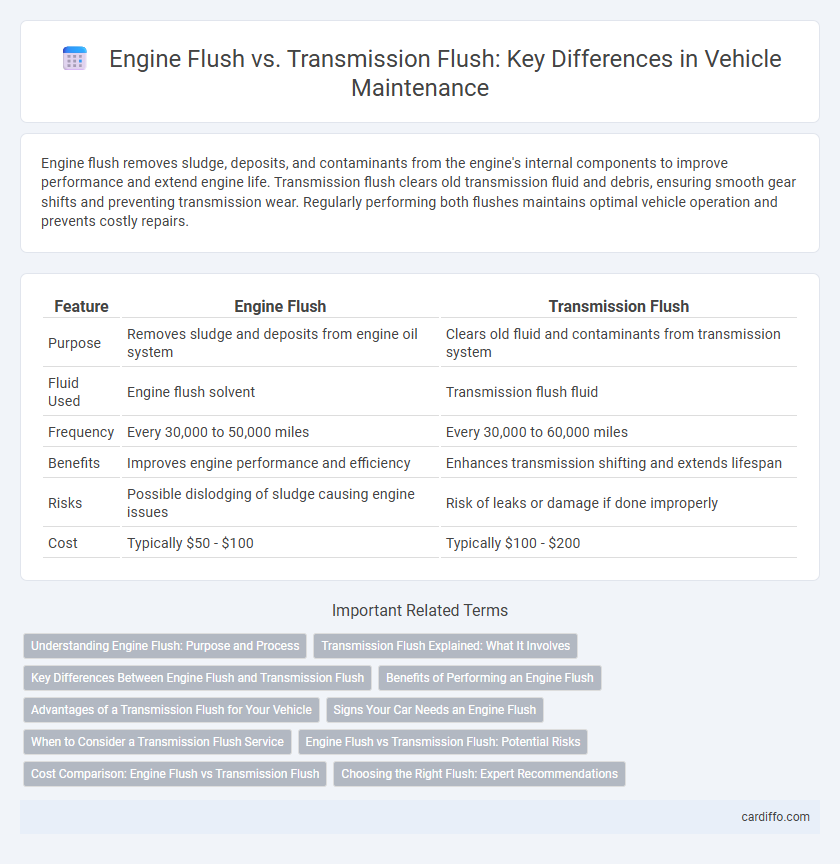Engine flush removes sludge, deposits, and contaminants from the engine's internal components to improve performance and extend engine life. Transmission flush clears old transmission fluid and debris, ensuring smooth gear shifts and preventing transmission wear. Regularly performing both flushes maintains optimal vehicle operation and prevents costly repairs.
Table of Comparison
| Feature | Engine Flush | Transmission Flush |
|---|---|---|
| Purpose | Removes sludge and deposits from engine oil system | Clears old fluid and contaminants from transmission system |
| Fluid Used | Engine flush solvent | Transmission flush fluid |
| Frequency | Every 30,000 to 50,000 miles | Every 30,000 to 60,000 miles |
| Benefits | Improves engine performance and efficiency | Enhances transmission shifting and extends lifespan |
| Risks | Possible dislodging of sludge causing engine issues | Risk of leaks or damage if done improperly |
| Cost | Typically $50 - $100 | Typically $100 - $200 |
Understanding Engine Flush: Purpose and Process
Engine flush involves circulating a cleaning solution through the engine to remove sludge, deposits, and contaminants that accumulate over time, enhancing engine performance and longevity. The process begins by adding a specially formulated engine flush additive to the oil before an oil change, running the engine briefly to allow the solution to dissolve buildup, and then draining the old oil along with harmful debris. Unlike a transmission flush, which targets the transmission fluid and components, an engine flush specifically cleans the internal parts of the engine to improve lubrication and efficiency.
Transmission Flush Explained: What It Involves
Transmission flush involves the complete removal of old transmission fluid by using specialized equipment to force new fluid through the entire system, which helps eliminate sludge, contaminants, and deposits. This process is more thorough than a simple transmission fluid change because it cleans the torque converter, transmission cooler, and lines, ensuring optimal performance and prolonging transmission life. Regular transmission flushes help maintain smooth shifting, prevent overheating, and reduce costly repairs caused by degraded fluid and internal buildup.
Key Differences Between Engine Flush and Transmission Flush
Engine flush involves cleaning the internal components of the engine by removing sludge, deposits, and contaminants that accumulate over time, which helps improve engine performance and fuel efficiency. Transmission flush targets the automatic transmission system by replacing old transmission fluid and removing buildup in the transmission pan, valves, and cooler lines, ensuring smoother gear shifts and prolonging transmission life. Key differences include their focus areas--engine flush cleans the engine's combustion system, while transmission flush maintains fluid quality and hydraulic function within the transmission.
Benefits of Performing an Engine Flush
Performing an engine flush removes built-up sludge, varnish, and deposits that impair engine performance and fuel efficiency. It helps restore optimal oil flow, reduces engine wear, and can extend the lifespan of critical components such as pistons, valves, and bearings. Regular engine flushes also promote cleaner combustion and prevent costly repairs by maintaining internal engine cleanliness.
Advantages of a Transmission Flush for Your Vehicle
A transmission flush removes old fluid and contaminants from the entire transmission system, enhancing shifting performance and extending transmission lifespan. Compared to an engine flush, it targets critical transmission components, preventing costly repairs by maintaining optimal hydraulic pressure and reducing wear. Regular transmission flushes improve fuel efficiency and ensure smoother gear transitions, supporting overall vehicle reliability.
Signs Your Car Needs an Engine Flush
White or black smoke from the exhaust and a noticeable drop in fuel efficiency are clear signs your car needs an engine flush. Engine knocking, rough idling, or hesitation during acceleration indicate buildup of sludge and deposits requiring immediate attention. Unlike a transmission flush which targets the transmission fluid and components, an engine flush specifically cleans internal engine parts to restore performance and prevent costly repairs.
When to Consider a Transmission Flush Service
A transmission flush service is recommended when experiencing symptoms like delayed gear engagement, slipping gears, or strange noises during shifting, as these indicate contaminated transmission fluid affecting performance. Regular transmission flush intervals typically range from 30,000 to 60,000 miles, but consult the vehicle manufacturer's maintenance schedule for specific guidelines. Engine flushes focus on cleaning internal engine components, while transmission flushes target the transmission system to remove old fluid and debris, ensuring smooth operation and prolonging transmission life.
Engine Flush vs Transmission Flush: Potential Risks
Engine flush involves using chemical solvents to dissolve sludge and deposits inside the engine, which can potentially dislodge particles that clog oil passages or damage seals if not done properly. Transmission flush circulates cleaning fluid through the transmission system to remove contaminants but risks washing away necessary transmission fluid or damaging seals if performed excessively. Both procedures require careful assessment of vehicle condition and adherence to manufacturer guidelines to avoid cost-intensive repairs or system malfunctions.
Cost Comparison: Engine Flush vs Transmission Flush
Engine flushes typically cost between $50 and $100, making them a more affordable routine maintenance option compared to transmission flushes, which range from $150 to $300 due to the complexity and labor involved. The higher price of transmission flushes reflects the need for specialized equipment and thorough fluid replacement to ensure proper transmission function. Vehicle owners should consider the cost-effectiveness and specific maintenance requirements when deciding between an engine flush and a transmission flush.
Choosing the Right Flush: Expert Recommendations
Engine flush involves cleaning the internal components of an engine by removing sludge and deposits, while transmission flush targets the removal of old fluid and contaminants from the transmission system. Expert recommendations emphasize selecting the flush type based on your vehicle's maintenance history and symptoms such as slipping gears or decreased performance. Routine checks of fluid condition and manufacturer guidelines are critical to determine whether an engine or transmission flush is necessary to ensure optimal vehicle operation and longevity.
Engine flush vs transmission flush Infographic

 cardiffo.com
cardiffo.com